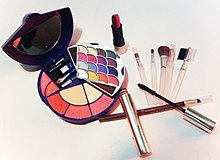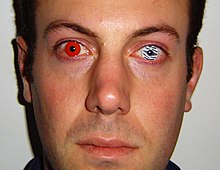Cosmetics: Difference between revisions
m ←Undid revision 116732394 by Krislongden (talk) spam |
|||
| Line 80: | Line 80: | ||
*[http://www.4woman.gov/faq/cosmetics.htm Cosmetics and Your Health] |
*[http://www.4woman.gov/faq/cosmetics.htm Cosmetics and Your Health] |
||
*[http://www.hc-sc.gc.ca/cps-spc/person/cosmet/hotlist-liste_e.html List of Prohibited and Restricted Cosmetic Ingredients (Health Canada)] |
*[http://www.hc-sc.gc.ca/cps-spc/person/cosmet/hotlist-liste_e.html List of Prohibited and Restricted Cosmetic Ingredients (Health Canada)] |
||
*[http://howtomakeyourselflookbeautiful.blogspot.com/ How To Use & Apply Cosmetics] |
|||
[[Category:Cosmetics| ]] |
[[Category:Cosmetics| ]] |
||
Revision as of 00:08, 22 March 2007

Cosmetics () are substances used to enhance or protect the appearance or odor of the human body. Cosmetics include skin-care creams, lotions, powders, perfumes, lipsticks, fingernail polishes, eye and facial makeup, permanent waves, hair colors, deodorants, baby products, bath oils, bubble baths, and many other types of products. Their use is widespread, especially among women in Western countries. A subset of cosmetics is called "make-up", which refers primarily to colored products intended to alter the user’s appearance. The manufacture of cosmetics is currently dominated by a small number of multinational corporations that originated in the early 20th century, but the distribution and sale of cosmetics is spread among a wide range of different businesses. The U.S. FDA defines cosmetics as: "intended to be applied to the human body for cleansing, beautifying, promoting attractiveness, or altering the appearance without affecting the body's structure or functions." This broad definition includes, as well, any material intended for use as a component of a cosmetic product. The FDA specifically excludes soap from this category. (http://www.fda.gov/fdac/features/1998/398_cosm.html)
History
The first archaeological evidence of cosmetics usage is found in Ancient Egypt around 4000 BC. The Ancient Greeks and Romans also used cosmetics. The Romans and Ancient Egyptians used cosmetics containing mercury and often lead.
In the western world, the advent of cosmetics was in the middle ages, although typically restricted to use within the upper classes.
Cosmetic use was frowned upon at some points in history. For example, in the 1800s, Queen Victoria publicly declared makeup improper. It was viewed as vulgar and acceptable only for use by actors.
By the middle of the 20th century, cosmetics were in widespread use in nearly all societies around the world.
The cosmetics industry today
The cosmetics industry is a multinational, multi-billion-dollar industry. Of the major firms, the oldest and the largest is L'Oréal, which was founded by Eugene Schueller in 1909 as the French Harmless Hair Colouring Company (now owned by Liliane Bettencourt 27.5% and Nestlé 26.4%, with the remaining 46.1% are publicly traded). The market was developed in the USA during the 1910s by Elizabeth Arden, Helena Rubinstein, and Max Factor. These firms were joined by Revlon just before World War II and Estée Lauder just after.
Controversy
The popularity of cosmetics in the 20th century has increased rapidly. Especially in the United States, cosmetics are being used by teens (especially teen girls) at a younger and younger age. Many companies have catered to this expanding market by introducing more flavored lipsticks and glosses, cosmetics packaged in glittery, sparkly packaging and marketing and advertising using girls. The social consequences of younger and younger beautification has had much attention in the media over the last years (see Developmental psychology).
Types of cosmetic
The various forms of makeup include:
- Lipstick, lip gloss, lip liner, lip plumpers.
- Foundation, used to color the face and conceal flaws to produce an impression of health and youth. Usually a liquid, cream or powder.
- Powder, used to set the foundation, giving a matte finish.
- Rouge, blush or blusher, used to color the cheeks and emphasize the cheekbones. This comes in powder, cream and gel forms.
- Bronzer, used to create a more tanned or sun-kissed look.
- Mascara, used to enhance the eyelashes.
- Eye liner and eye shadow, used to color and emphasize the eyelids (larger eyes are a sign of youth).
- Eyebrow pencils, creams, waxes, and powders are used to fill in and define the brows.
- Nail polish, used to color the fingernails and toenails.
- Concealer, a type of thick opaque makeup used to cover pimples, various spots and inconsistencies in the skin.
Also included in the general category of cosmetics are skin care products. These include creams and lotions to moisturize the face and body, sunscreens to protect the skin from damaging UV radiation, and treatment products to repair or hide skin imperfections (acne, wrinkles, dark circles under eyes, etc.). Cosmetics can also be described by the form of the product, as well as the area for application. Cosmetics can be liquid or cream emulsions; powders, both pressed and loose; dispersions; and anhydrous creams or sticks.
Extreme cosmetics

In addition to over-the-counter cosmetic products, recent years have seen an increasing market for prescription or surgical cosmetic procedures. These range from temporary enhancements, such as cosmetic coloured contact lenses, to major cosmetic surgery.
Many techniques, such as microdermabrasion and chemical or physical peels, remove the oldest, top layers of skin cells. The younger layers of skin left behind appear more plump, youthful, and soft. Permanent application of pigments (tattooing) is also used cosmetically.
Ingredients


The ingredients of cosmetics come from a variety of sources. Cosmetics often use vibrant colours that have been derived from sources ranging from crushed insects to rust.[citation needed] Modern techniques have allowed manufacturers to produce colours synthetically.
The ingredients used in cosmetics are highly regulated in many countries. The testing of cosmetic products on animals is a subject of some controversy. It is now illegal in the United Kingdom, the Netherlands, and Belgium, and a ban across the European Union is due to come into effect in 2009.
See also
- Testing cosmetics on animals
- Body art
- Cosmeceutical
- Cosmetic surgery
- Henna
- List of cosmetic brands
- Permanent makeup
Notes
References
- "Ibn Sina's writing on Beauty"
- Burckhardt, Titus. Moorish Culture in Spain (in German). London: George Allen & Unwin. ISBN 1-887752-28-5.
{{cite book}}: CS1 maint: unrecognized language (link)
